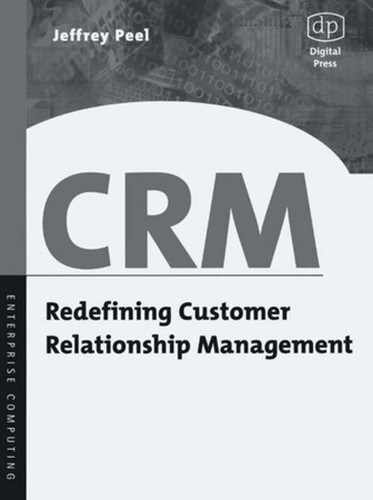
116 7.8 Portals (again)
7.8 Portals (again)
Coincident with the development of MRM, we're also seeing the emergence
of corporate portals and Web services. Customer knowledge workers will
become more and more dependent on aggregation of customer data. Informa-
tion about customers may well pervade the organization. The marketing
database will be required to poll disparate databases. Meanwhile, third-party
data sources will become more and more important, such as news feeds and
content from product marketing teams, account management staff, and the
contact center. The front-office portal will provide customer knowledge
workers with fingertip control of these resources and will allow dialog oppor-
tunities to be constructed using all the necessary information sources. All
personnel required to interface with the customer or to make decisions about
the customer relationship will use such a portal.
The key thing to remember is that the front-offlce portal is operational,
not informational. Where in the past CRM applications were used simply by
certain nominated groups, the front-office portal, MRM system, or marketing
CRM system, whatever we choose to call it, will drive the business. MRM sys-
tems will arrive at the point of sale, should the point of sale be in a retail
establishment or on the Web. As well as supporting a variety of sales channels,
it will support a variety of communications channels and myriad personnel
types within the organization, who may be required, in some guise, to support
the customer.
If this sounds like overkill, let me assure you that it is not. Centralized sys-
tems, accessible by all in the organization who need to access them via a
browser interface, make sense. Why build disparate customer systems and be
faced with myriad integration concerns? Instead, we'll see the Internet used as
an integration and informational conduit, uniting the customer with all key
constituencies within the vendor organization.
Therefore, both customers and vendors will become more dependent on
portals. Portals will be the operational and informational toolsets for vendors
to understand and communicate with customers and prospects. Customers
will also access these same portals, to define their own information needs or to
initiate dialog. The views will be different, but the data sets will be identical.
The key functions performed by the portal would include the following:
9 Two-way interaction: outbound and response
9 Outbound communication planning

7.8 Portals (again) 117
9 Database analytics
9 Response analytics
9 Content management
9 Personalization
9 Collaboration
9 Input to strategic planning and brand management
The relative importance of these features will vary, depending on the
nature of the vendor's business and channel strategy. Channels can also be
incorporated into the mix by the creation of portal-based extranets overtly
designed to support the needs of channel partners.
I Chapter 7

..................Content has been hidden....................
You can't read the all page of ebook, please click here login for view all page.
